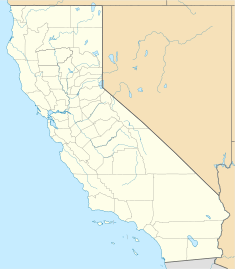Santa Ysabel Asistencia facts for kids

The Church of Saint John the Baptist, erected on the site of the original Santa Ysabel Asistencia in 1924.
|
|
| Location | Santa Ysabel, California |
|---|---|
| Coordinates | 33°7′49″N 116°40′41″W / 33.13028°N 116.67806°W |
| Name as founded | Asistencia de la Misión San Diego de Alcalá |
| English translation | Sub-Mission of the Mission San Diego de Alcalá |
| Patron | Saint Elizabeth (Isabel), Queen of Portugal |
| Nickname(s) | "Church of the Desert" |
| Founding date | September 20, 1818 |
| Founding priest(s) | Father Fernando Martín |
| Military district | First |
| Native tribe(s) Spanish name(s) |
Kumeyaay (Ipai), Payomkowishum Diegueño, Luiseño |
| Native place name(s) | Elcuanan |
| Governing body | Roman Catholic Diocese of San Diego |
| Current use | Chapel / Museum |
| Reference no. | #369 |
The Santa Ysabel Asistencia was like a small branch of a larger mission. It was started on September 20, 1818. This "sub-mission" was located in the mountains east of San Diego. It was near a village called Elcuanan.
Its main job was to be a rest stop for people traveling between San Diego and Sonora. About 450 native people lived there. These included the Luiseño and Diegueño tribes. Many people there chose to become Christians, more than at other California missions. Because it was so far away, priests did not visit often. This was especially true after the missions were no longer run by the church in the 1830s.
Contents
History of Santa Ysabel Asistencia
The Mission Era (1769–1833)
Father Juan Mariner first visited this area in 1795. In 1816, priests from the main San Diego mission asked for permission. They wanted to build this branch mission. Father Martin led the first church service in September 1818.
By 1821, several buildings were finished. These included a chapel, a place to store grain, and adobe houses. There was also a cemetery. In the same year, Father Mariano Payeras visited. He hoped to build more missions inland. Santa Ysabel was meant to be the most important one. However, this big plan never happened.
The Rancho Era (1834–1849)
In 1834, the missions were no longer controlled by the church. This change was called secularization. In 1844, Jose Joaquin Ortega and Edward Stokes received a large piece of land. It was called Rancho Santa Ysabel.
A road for wagons passed through the area. It connected San Diego to Warner's Ranch. In 1846, General Stephen W. Kearny and his "Army of the West" camped here. They were on their way to the Battle of San Pasqual.
Jean Baptiste Charbonneau also camped at the mission in 1847. He was the son of Sacagawea. He had guided the Mormon Battalion from New Mexico to San Diego. In 1849, a U.S. Army officer named A.W. Whipple visited. He wrote that the mission was "in ruins."
California Becomes a State (1850–1900)
By 1850, the roof of the church had fallen in. People put up shelters against a wall to continue church services. John Russell Bartlett, a traveler, saw the mission in 1852. He said it was mostly a church without a roof and a few simple huts. Today, none of the original buildings remain. They were lost due to years of neglect.
By 1857, American settlers lived there. A stop for mail coaches was also set up. This line connected San Diego to Carrizo Creek Station. It ran through Santa Ysabel until 1860. In 1898, the Santa Ysabel Indian Reservation was created.
The 20th Century and Today (1901 – present)
Later, three acres of the mission land were given back to the Roman Catholic Church. In 1903, Father Joseph Exalaphat Lapointe came to Santa Ysabel. He was a missionary from Canada. He worked with the local people.
A new chapel was planned. Its first stone was laid on September 14, 1924. This new chapel was built in the Mission Revival Style. It stands where the old adobe building used to be. Father LaPointe passed away in 1932. He was buried next to the chapel.
The Mystery of the Lost Bells
Bells were very important for daily life at any mission. They rang for meals, work, and church services. They also rang for births, funerals, and when visitors arrived. New priests learned special ways to ring the bells.
In 1846, two old bells were bought from another mission. They came from Misión Nuestra Señora de Loreto Conchó in Loreto, Baja California Sur, Mexico. They were traded for six loads of barley and wheat. The bells had special words on them: "N.S. De Loreto 1723" and "San Pedro 1767."
As the mission fell apart in the 1830s, the bells were hung on a wooden frame. Then, one summer night in 1926, the bells disappeared! It seemed they were stolen. The next day, a local man named Jose Maria Osuna found the clappers (the parts that hit the bell to make sound). He kept them safe. After Osuna died, the clappers were passed down. They were finally returned to the mission in 1959. In 1966, a piece of one bell was found. No one ever said where or how it was found.
In 1993, a local metal worker named Ed Schwaesdall and his son John made a new bell. It was made mostly of brass and copper. They gave it to the mission to celebrate its 175th anniversary. In 2012, another piece of one of the original bells was found. This happened after an old story about them was discovered.
See also




